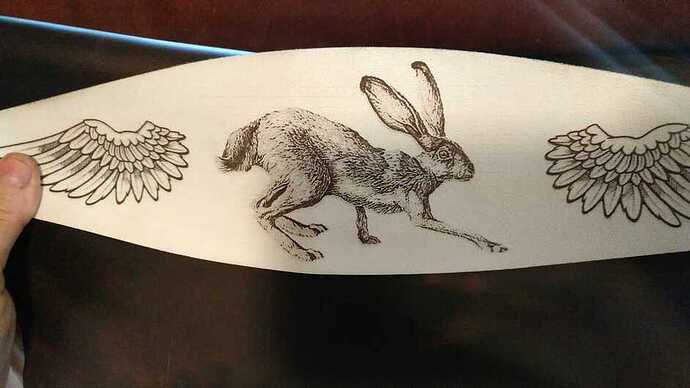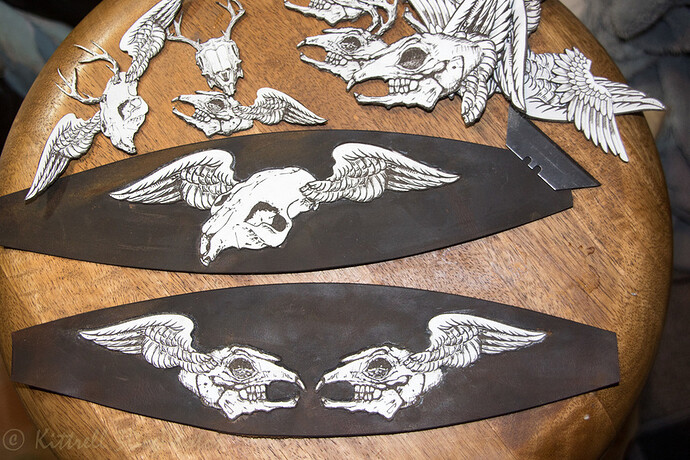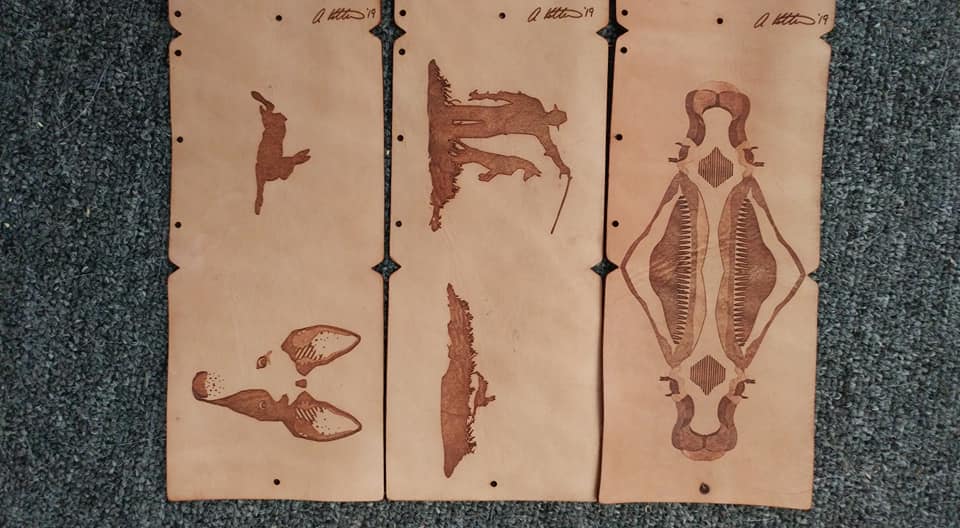Makes sense. Though, is it clear that it will fully oxidize in the conditions in the laser cutter with the air assist continually arresting combustion by reducing temperature?
That’s a great point. The flip side of it is that it’s pretty efficient a spreading fine breathable particles into the air. I think the best practice is to avoid when possible, and let the particles (residual smoke) settle before opening the lid when not possible.
Just as an example. The brown stuff is real leather of unknown origin and likely oil tanned. The white stuff is chrome tanned from somewhere. Both cut and engraved well.
For those who might be in the know, how do you tell if a pleather is “bad”?
For some context, my wife is a seamstress and has taken a job where she needs to use some pleather, because her machines won’t handle the thin clothing leather. (specifically this stuff) But it needs a LOT of cutout detail work that would look MUCH better and quicker if cut by a laser instead of an exacto knife.
I’ve cut a piece, put it on a copper wire and burnt it. It had a red/orange flame and not green, so I’m hoping that it is safe to use.
Obtain the list of ingredients from the manufacturer. See what the supplier knows. Other than that, IDK - find a chemist?
I’ve read about quality fake leather that is a microfiber made from what should be safe materials.
I tried looking up an SDS or MSDS for this fabric and I was unable to find one.
I’ll see if I can find who the manufacturer is and if there is contact information for them.
If you can find it out you may want to see if you can buy it in quantities less than what a factory requires. It’s been a while since I looked, but I’ve never found a seller of high quality, laser-safe, fake leather for small lots.
A garment quality fake leather that cuts well is, oh I don’t know, a potential proofgrade thing?? @michelle, @dan.
The Yaya Han cosplay pleather is sold in Joann Fabrics stores. So we can get as much or as little of it as we want. I think I found the group that makes, produces, or coordinates getting the Yaya Han fabric to retailers (https://www.cosplayfabrics.com/collections/yaya-han-collection), so I’ll see if they respond with any useful information about laserability. If it looks good, then you might have a good source at your local Joann Fabrics store!
What?!?!?! I have to go to a store. What is this the dark ages??
Oh, it’s available online.
Bless geeks!
Gorgeous work, as always, @kittski
Thank you so much for the response.
Thanks all of you for weighing in on this.
I want to be reasonably safe-ish, but I am willing to accept a certain level of risk in my life.
You all are fantastic.
What a great community!
EDIT: No Green!
It smells like burned skin - AKA veg-tanned, known-source, laser-OK, stinky dead skin, real leather. So it isn’t pleather.
This commentary is on the smell test, which is, I know, not a real classification. The smell test doesn’t identify the tanning process; but that there is real leather in there.
Got satisfactory results after 3 tries with a sample piece.
Any advice on best practices for cleaning off soot?
They responded and just said that they don’t have an MSDS sheet for this fabric. They recommended not putting it in the laser because of scorching/melting concerns, but nothing mentioned about harmful toxins.
Edit: I tried it in the laser and it cut really well.
I used leather conditioner for the soot and it worked well.
A chemistry note: anything with copper salts will burn green . I think the test for chrome works if the chrome replaces copper a little bit and thus that is the source of the green. The bright yellow is sodium which is nearly everywhere and may over shade the green.
I used to have dydinium glasses that are opaque the sodium yellow and one reason glass crafters use them. They are also opaque in part of the infrared spectrum. My understanding is that the iron green glass is also opaque in a slightly different part of the infrared. I knew a professor that was a hobby furnace glass artist who wore the dydinium glass with iron glass flipdowns and claimed it covered the entire infrared, and a hot glass furnace has a lot of infrared across the entire spectrum.
I know the CO2 laser by its nature is a very narrow range but I wonder if any others here know if the iron or dydinium or neither covers the area of the laser?
That link says that it is a polyurethane blend with polyester. Polyurethane when burned in such a way that it can’t oxidize completely (low oxygen environment or perhaps when being actively cooled by air assist) apparently produces more hydrogen cyanide by volume burned than other carbon based materials. It’s a pretty dangerous gas (flammable and toxic at some concentrations), but it’s not clear to me how much gets produced in typical laser cutting operations. But it isn’t necessarily bad for your laser cutter unless it catches on fire.
Well in fairness there is a complex system to keep it from usually eating a hole through you (although I see plenty of ulcers in my practice and have had 2 myself) and burns (like esophagitis) but believe me if you poured pH of 1 HCL on your arm it would burn you badly. Your stomach has a thick layer of acid proof mucous to prevent burn through. And then when the food exits your stomach your small intestine pours out NaHCO3 (sodium bicarbonate = baking soda) to buffer it (actually the duodenum which is the first part of intestine right out of the stomach is the most common site of ulcers actually not the stomach). Every night we all aspirate a small amount of HCl into our lungs (it’s OK, that’s what keeps it sterile otherwise we’d all have aspiration pneumonia). But generally HCl needs to stay in the stomach.
Hi Everyone!
Thank you for all the info. I am etching some leather patches that will be sewn on hats, and I’m not sure the best way to go about it. When I etch the leather it looks great, but then the burnt areas smear and it looks sloppy. When I try to clean it up with duck tape the etched area looks all splotchy. What is the best way to make these patches and have them not smear??
The problem is that the laser is burning away material, therefore what is left is often char. Char smears. I’ve done a couple of leather engraves and haven’t really had this issue, however, they were for low use items.
I would recommend using the Saddle Collection from Johnson Plastics. It is a faux leather designed for this very application. And it is thin and flexible enough you should be able to machine sew it with a good sewing machine rather than hand stitching.
You can find an excellent exploration of settings in this post:
I clean my engraved leather with leather conditioner. It breaks up the char and prevents it from sticking to the leather. Works really well for me and has the bonus of making the leather softer.
Was your suggestion ever implemented?
The suggestion to create a database with pics? I think that was actually someone else’s idea that I riffed on (not finding the link, unfortunately), and I don’t see that it ever was made real.


